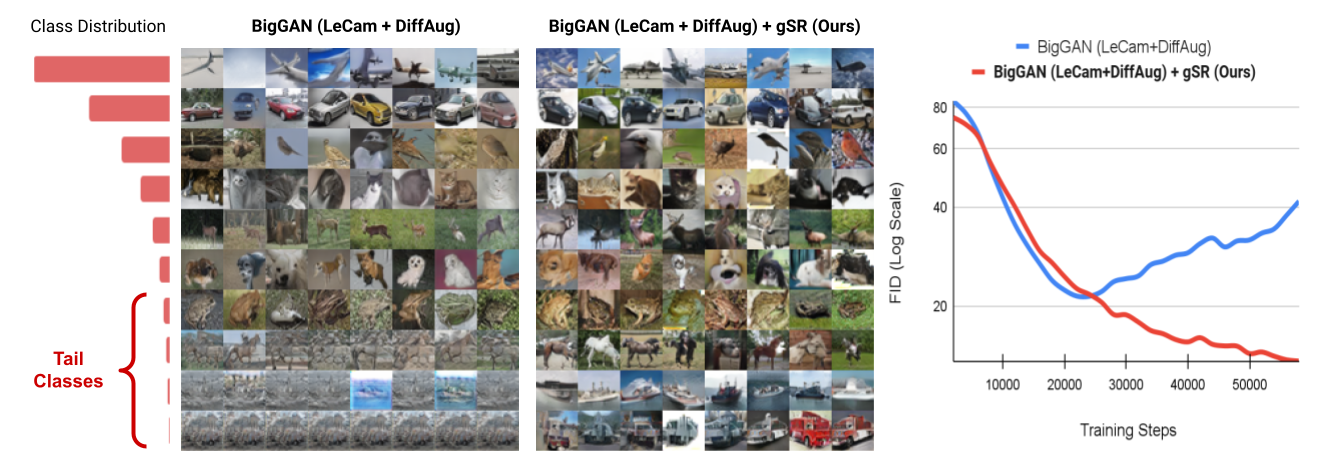This repository contains code for the paper:
Improving GANs for Long-Tailed Data through Group Spectral Regularization
[Paper][ProjectPage]
Harsh Rangwani, Naman Jaswani, Tejan Karmali, Varun Jampani, R. Venkatesh Babu
Indian Institute of Science, Google Research
European Conference on Computer Vision (ECCV) 2022
Deep long-tailed learning aims to train useful deep networks on practical, real-world imbalanced distributions, wherein most labels of the tail classes are associated with a few samples. There has been a large body of work to train discriminative models for visual recognition on long-tailed distribution. In contrast, we aim to train conditional Generative Adversarial Networks, a class of image generation models on long-tailed distributions. We find that similar to recognition, state-of-the-art methods for image generation also suffer from performance degradation on tail classes. The performance degradation is mainly due to class-specific mode collapse for tail classes, which we observe to be correlated with the spectral explosion of the conditioning parameter matrix. We propose a novel group Spectral Regularizer (gSR) that prevents the spectral explosion alleviating mode collapse, which results in diverse and plausible image generation even for tail classes. We find that gSR effectively combines with existing augmentation and regularization techniques, leading to state-of-the-art image generation performance on long-tailed data. Extensive experiments demonstrate the efficacy of our regularizer on long-tailed datasets with different degrees of imbalance.
CIFAR-10 dataset will be downloaded automatically in ./data folder in the project directory.
For LSUN dataset download please follow the instructions here on how to download, then update the config file with the dataset path.
The long-tailed version of the LSUN and CIFAR-10 datasets will be created automatically by code.
For iNaturalist2019 dataset please download the files from the following link: here. After download untar the images, following which use the script available here to create image file names.
For installing all the requirements use the following command:
conda env create -f environment.yml -n gsrgan
We provide examples of running the experiments for CIFAR-10 dataset. For other datasets the experiments can be run similarly by changing the path to appropriate configuration present in src/configs. Our code base currently supports SNGAN and BigGAN architectures. We apply the state-of-the-art LeCam and DiffAugment regularization to obtain competent baselines.
For running the proposed SNGAN with gSR use the command:
python3 src/main.py -t -e --config_path ./src/configs/CIFAR10/SNGAN.json
For running the proposed SNGAN with gSR use the command:
python3 src/main.py -t -e --config_path ./src/configs/CIFAR10/BigGAN.json
For running the baseline experiments please set sn_regularize=false in the configuration files of the corresponding experiments.
For evaluation make the evaluation_checkpoint=True in configuration and specify --checkpoint_folder of the model while running the command, for getting the evaluation metrics. Please note that the validation metrics logged while training may be different from final evaluation metrics.
We have commented ## Added for all the code addition done by the authors. The majority of implementation of gSR is present in the file src/utils/model_ops.py.
We thank the creators of awesome repository of PyTorchStudioGAN on which our implementation is based on.
If you find our code or work useful in any way, please consider citing us:
@article{rangwani2022improving,
title={Improving GANs for Long-Tailed Data through Group Spectral Regularization},
author={Rangwani, Harsh and Jaswani, Naman and Karmali, Tejan and Jampani, Varun and Babu, R Venkatesh},
journal={arXiv preprint arXiv:2208.09932},
year={2022}
}
Please contact harshr@iisc.ac.in in case you have any comments or suggestions.
